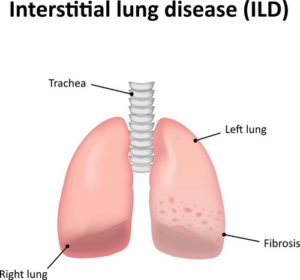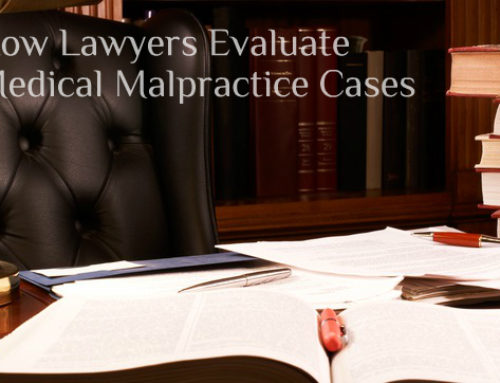Connecting the Dots Between an Interstitial Lung Disease & Your Workers’ Comp Claim
What Is Interstitial Lung Disease?
Interstitial lung disease is the name of a group of disorders, most of which result in the progressive scarring of the lungs. By definition, ‘interstitial’ means “Occurring in or being an interval or intervening space or segment: of, relating to, or forming an interstice.” The interstice is the space between two areas. In the case of lung disease, interstitial refers to the scarring that occurs around the air sacs, or alveoli, when the lungs try to heal. The scar tissue thickens the area, limiting how much oxygen you can breathe in.
Interstitial lung disease has many causes, including both occupational environmental factors. Sometimes the cause of the disease is never known. In order to make a workers’ compensation claim, you must be able to prove that your condition resulted from exposure to toxins or pollutants at work.
Are You at Risk for Lung Disease at Work?
Some work environments pose a known threat to workers. For example, working with asbestos, exposure to radiation, or exposure to silica dust are factors known to cause lung disease, particularly with long-term exposure. But some causes aren’t as easily recognized. Sometimes exposure to birds or animal droppings leads to lung disease. If you work on a farm or in a pet store, you could be at just as great of a risk as working with toxins and chemicals known to cause disease.
In addition to exposure to airborne toxins, certain medications and medical treatments can cause the condition too. Inhaling the bacteria from indoor hot tubs is another potential cause. People who are exposed to radiation as a form of cancer treatment sometimes don’t show symptoms of lung disease until months or years later. That means your pre-existing health conditions and treatments can have an impact on your workers’ comp claim.
Drugs That Cause Interstitial Lung Disease
Chemotherapy and radiation treatment are the two types of treatments for cancer. Both can cause damage to the lung tissue, resulting in lung disease. A number of other drugs can cause lung disease as well. Some antibiotics, including nitrofurantoin and ethambutol, are known to cause lung damage. Nitrofurantoin is used to treat bacterial urinary tract infections. Ethambutol is used to treat Mycobacterium tuberculosis.
Azulfidine is a medication used to treat various types of inflammatory bowel disease. Although the connection between IBS patients and the development of lung disease is not well understood, there is a high incidence of patients who develop lung disease following treatment with Azulfidine.
Lung Disease Resulting from Autoimmune Disease
An autoimmune disease is one in which your body mistakes some cells as foreign, causing it to launch an immune response against your body’s healthy cells. Sometimes these conditions can lead to lung damage. One autoimmune disease that many people are most familiar with is rheumatoid arthritis, but there are many more.
Symptoms
Your inability to take in oxygen will leave you feeling breathless. You could also have a dry cough. By the time these symptoms appear, serious lung damage has usually already occurred. Many cases are overlooked or misdiagnosed. Failing to recognize the potential risks of the disease allows it to progress without the treatment needed to slow it down.
At one time, doctors considered interstitial lung disease as rare. Thanks to medical experts who have made an effort to increase awareness, a larger number of cases are being identified. Certainly, exposure to certain types of toxins plays a role. It’s not surprising that there is more known about lung disease caused by exposure to environmental hazards but there are other causes. The increase in awareness has led to some other discoveries in cases of lung disease that have helped identify risk factors. These include:
- Age – Most cases of lung disease affect adults
- Gastroesophageal Reflux Disease (GERD) – Uncontrolled acid reflux or indigestion increases your risk of lung disease
- Cancer Treatment – People who have radiation or chemotherapy to their chest area or who use high-risk drugs increase their risk of developing lung disease
- Smoking– People who smoke are more vulnerable to the development and complications of lung disease
Complications
Initially, your lung disease will make it difficult for you to breath. Your body will no longer get the oxygen it needs to function normally. The lung tissue will become increasingly damaged, leading to potential complications that are life-threatening.
– Pulmonary Hypertension – Unlike normal high blood pressure, this condition only affects the arteries in your lungs. The reduction in oxygen flow in your lungs causes an increase in pressure within the arteries.
– Right Sided Heart Failure – The right chamber of your heart has less muscle than the left chamber. When it has to pump harder to move blood through your arteries, it eventually fails due to the strain.
– Respiratory Failure – During the final stage of disease, severely low blood oxygen levels and increased pulmonary pressure in the arteries and the right ventricle lead to heart failure.
Diagnosis
Doctors use a broad range of tests to diagnose interstitial lung disease including:
- Blood Tests
- Chest X-rays
- Surgical Biopsy
- Pulmonary Function Tests
- Chest CT
…and many more.
Treatment
The most important thing for you is to get a diagnosis and treatment as soon as possible. Scarring isn’t reversible, but treatment may help to stop or slow the progression of the disease. Some medications help improve quality of life and allow you to do more of the things you enjoy.
Medications include corticosteroids that suppress the immune system, those specific to idiopathic pulmonary fibrosis, and drugs that reduce the symptoms of GERD.
Patients with interstitial lung disease are often given oxygen to make breathing easier. Oxygen also helps reduce or prevent common complications caused by low blood oxygen levels. It reduces the blood pressure in the right heart chamber and improves sleep and your feelings of well-being.
You might want to examine your options for taking part in clinical trials. Sometimes this option gives you access to new treatments that would otherwise not be available.
For some people, lung transplantation is the last resort. If the disease isn’t detected early enough or other treatments haven’t worked, this might be the only option in severe cases.
The Role of Workers’ Compensation
After your diagnosis, the next step is to prove that your work environment caused your lung disease. The challenge in proving that your lung disease is a work-related illness is that there are many causes. Often, the actual cause isn’t known. Keep in mind that interstitial lung disease actually refers to a group of disorders that includes more than 200 types. These include pulmonary fibrosis (IPF), interstitial pneumonia, and sarcoidosis. While all forms of the disease affect the network of tissue that runs through both lungs (the interstitium), the differences between different forms of the disease can make it even more difficult to detect.
If your doctor knows you have a medical condition that can cause lung disease, they can observe your condition and catch problems early on. When your condition is work-related, you may not realize the risk until you develop lung disease and it progresses far enough along to lead to noticeable symptoms.
One example is that of injuries that occur on construction sites. What you might not realize is that working at some construction sites also puts you at risk for illnesses like interstitial lung disease. Workers are often aware that there is asbestos in older buildings. But the idea that the material’s use in the United States is fully banned is not true. This toxic material is still found in some types of building insulation, auto parts, fireproof clothing, and some types of construction materials. You could be working with harmful products without realizing your risk.
Whether the risk of exposure to toxins is known or not, you have the right to collect workers’ comp for any work-related illness or injury. Think about how long coal miners have known about the risk of getting black lung due to their work environment. It isn’t a matter of whether you were aware of the potential risk, but of whether the cause was work-related.
Many industries work with chemicals and toxins that put their workers at risk. In addition to construction, textiles, quarries and mines, painting, agricultural farms, chemical plants, refineries, automotive plants, and many other industries do pose a risk to workers. Employers must create safe work environments and supply appropriate safety equipment by law. When they fail to meet these requirements, they may be guilty of negligence. If your employer’s negligence led to your interstitial lung disease, you need to contact a personal injury attorney right away. They can tell you whether you have a valid case and how much time you have to file a claim.
The Importance of Exposure
Exposure refers to the amount of contact you have with the toxic substance. This factor is what determines whether the exposure at work is what caused the lung disease. The amount of exposure you have to an offending substance includes the amount, the length of time of exposure, and how frequently the exposure occurred.
A worker’s background also goes into the equation. If you have existing lung disease, are a smoker, or have a history of allergies, these may contribute to the causation of your lung disease. Even if you have risk factors that make it more likely to develop lung disease, you may still have a valid claim. Depending on your level of exposure and other factors, the industrial exposure is also a contributing cause. If there is a possibility that the disease wouldn’t have developed without the exposure, then it is still a work-related illness.
Interstitial lung disease that occurs due to occupational exposure is considered preventable. It is up to the employer to know the risks of using certain materials and the conditions of work sites. It is also their responsibility to provide safety equipment and monitor the exposure of each employee so they can stay on top of any potential risks.
What to Expect from Interstitial Lung Disease
The broad range of causes and types of the disease make the prognosis and life expectancy different for every person. The disease progresses much faster in some patients than in others. Some experience mild symptoms while others have severe symptoms.
People with idiopathic pulmonary fibrosis have a limited outlook. The survival rate is typically between three and five years, although certain medications can make it longer. Those with sarcoidosis often live a lot longer.
You can do some things to improve your health while undergoing treatment. If you smoke, stop. Smoking only adds to the damage in the lungs. Eat a healthy, well-balanced diet with enough nutrients. Get plenty of exercise and talk to your doctor about the benefits of using oxygen. Also, get vaccines for respiratory illnesses like the flu or pneumonia that can worsen lung symptoms.
Where to Start
Most people who develop work-related interstitial lung disease will eventually be unable to work. Even if your symptoms are minor in the beginning, any progression can limit your ability to perform. Some people manage to work a non-physical job like sitting at a desk for several years. Your ability to work depends on the type of work you do, the form of lung disease you have, and how well you respond to treatment.
The problem with work-related lung disease is that you don’t want to continue exposing your body to the toxins that caused your initial condition. Taking care of yourself will help increase the likelihood that treatment will work. If your employer is responsible for your condition, you deserve compensation to cover your medical bills and your loss of income.
Start by scheduling an evaluation with an experienced workers’ compensation attorney. You also want an attorney who knows your rights regarding personal injury law. If the damages to your health exceed those allowed by law under workers’ comp, your attorney can advise you on your options for getting a fair settlement.
If you have interstitial lung disease that you know or suspect originated from your work environment, contact Ingerman & Horwitz to schedule an evaluation. We are here to help you find out if you have a case.















